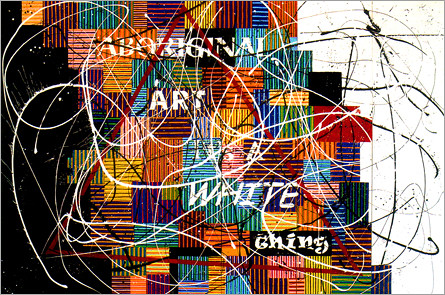Historically when most of us, myself included, ponder the appearance of Indigenous art it is the traditional dot paintings, crosshatching or ochre on bark that would usually formulate in our minds. However, contemporary Indigenous art is clearly taking a new direction and being approached with as much diversity as the Indigenous culture and the artists creating the works. Some of the of urban Indigenous artists at the forefront of this movement are the likes of Tracey Moffatt, Sally Morgan, Judy Watson, Destiny Deacon, Vernon Ah Kee and the controversial Richard Bell to mention just a few. However, it would appear that much of the evolution within the Indigenous art movement is due to the many Indigenous artists of the latest generation that are emerging from an educational based background within the arts. Consequently, I believe the appearance and style of much of the traditional Indigenous arts are changing and evolving into a new era of cultural expression and therefore making it more accessible to the general public.
 |
Richard Bell – E. Metaphysica Bell’s Theorem (Aboriginal Art It’s a White Thing), 2003 |
The evolution of Urban Aboriginal art began through the 1960 and has advanced at the same time as the phenomenal growth of more traditional Aboriginal art pursuits in the more remote areas. Urban Aboriginal artists have forged ahead using this art as a powerful forum for political expression and social commentary experimenting with various methods of expression from drawing, painting, printmaking and digital mediums such as photography and video. However, the journey for many Urban Aboriginal artists has been a battle against the typical stereotyping of what traditionally constitutes as Aboriginal art that is considered more authentic. It would be unfortunate if the strong attraction to traditional Aboriginal artworks detracted from the positive reception of contemporary Aboriginal artists who in their own right are authentic even use a less traditional approach or different media.
In lecture and tutorials on Wednesday14th September an interesting topic was raised..."What does it mean to be an Urban Aboriginal Artist?" Is this label loaded with its own connotations? Does it imply the creators of this type of art only come from the city, or that they are not bush people, or perhaps that the artists are not fully aboriginal and not producing authentic aboriginal art? Does it raise more questions than answers, create more labels and magnify the separation between white Australians and those of an Indigenous background, whether traditional or contemporary. As individuals and a nation who are desperately trying to reconcile our history and future directions, when referring to a modern art movement wouldn’t we be better to use an all encompassing phrase that is more inclusive of all modern Australian artists, such as "Contemporary Australian Art"? If we remove the labels….what do we have left? Just Art!
No comments:
Post a Comment